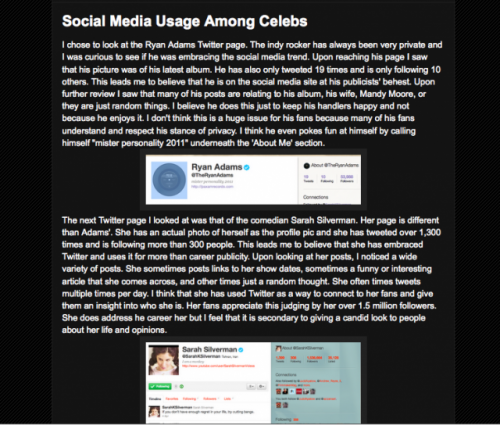
Image Credit:
Elizabeth Frye
Social media has long stood out to me as something rhetoric instructors should discuss in the classroom. Aside from email, it is perhaps the most commonly used technology by our students and ourselves. Increasingly, it’s the medium through which we access news stories and forms of information and promotion. Yet, because it raises questions about the overlap between public and private and what’s acceptable or desired in terms of pedagogy, I’ve often hesitated to use it. I don’t necessarily want students to find me on Facebook or Twitter, and I think that most of them would feel the same way. That said, using either of those social media sites as a means of communication for my class has been something I’m avoided. While I know other instructors have used them with great results, I haven’t figured out a way to make them work for me. However, I still think they provide a significant opportunity for discussing argument and appeals.
Because I teach RHE 309K – The Rhetoric of Celebrity, it makes a lot of sense to talk about the use of social media in popular culture. Throughout the semester, students observe and analyze various sorts of media—print and digital—in which arguments are made about particular celebrities and cultural relevance. They also are asked to observe and analyze how celebrities make arguments about themselves. Because social media increasingly functions as a legitimate PR campaign for both celebrities and celebrities as businesses, examining the field allows them to think about digital ethos, argument, and multiple audiences.
I ask them to examine a celebrity Twitter feed or Facebook page of their choice and then in a developed blog post on the class blog to evaluate the celebrities’ social media presences in terms of argument and rhetoric. They consider who appears to be speaking, i.e. if it appears to be the celebrities themselves or their handlers. I ask them to think about how the celebrities imagine or gesture to a viewing audience. I also ask, what kind of ethos is promoted? Are there other rhetorical strategies being used (kairos, logos, pathos)? Are there conversations with others? Who is being addressed or not addressed? Because we’ve already dealt so much with visual rhetoric, students also examine the visual impact of the page and how it connects with the celebrities’ images in terms of other images that are circulating about the celebrities. Students also post screenshots to the blog.
In class we discuss whether there seems to be a common rhetoric and whether celebrity use of social media appears to be different from or seems to align with regular folks’ tweeting and posting. The exercise allows all of us to discuss social media in a way that preserves personal boundaries but is also directly relevant to the content of the course.

